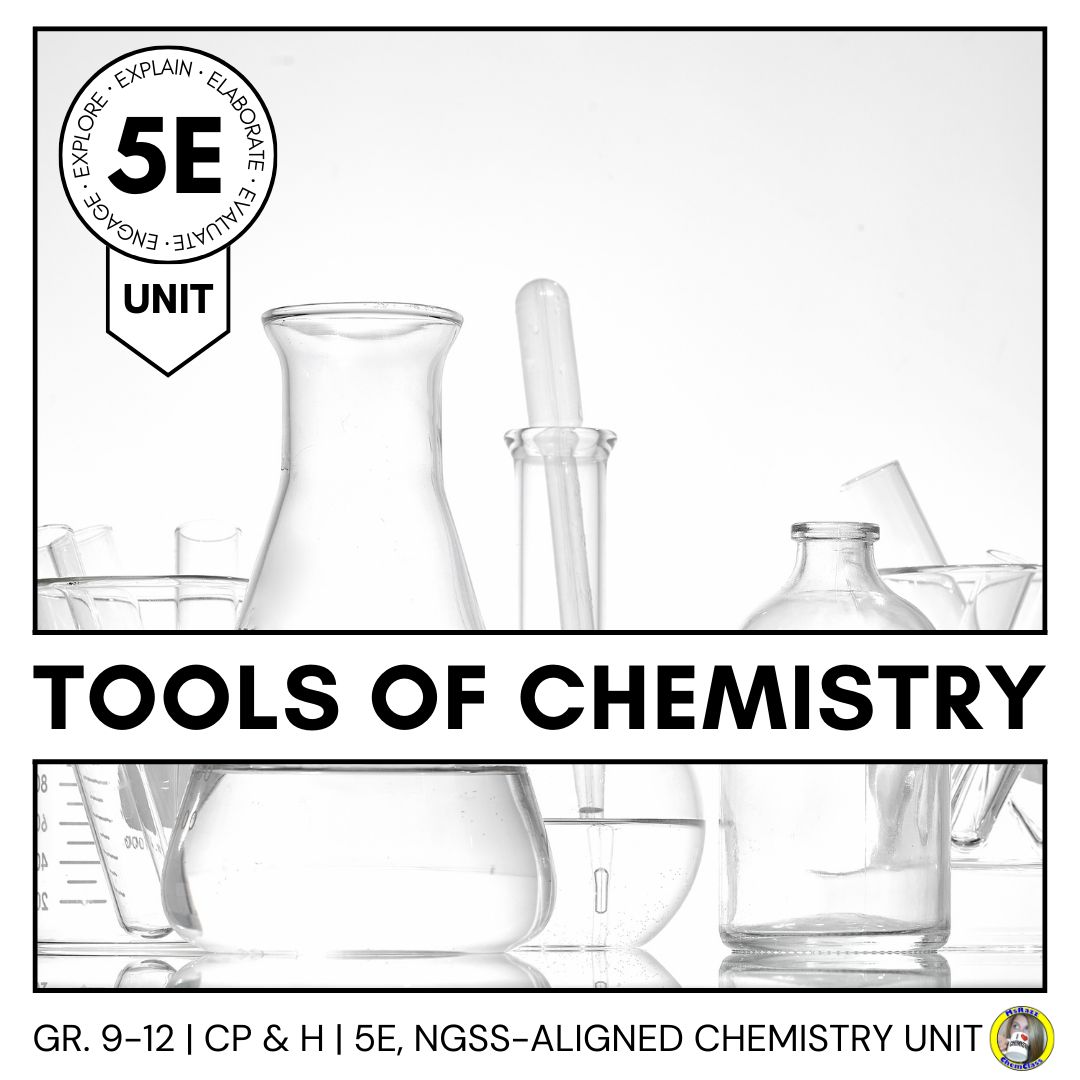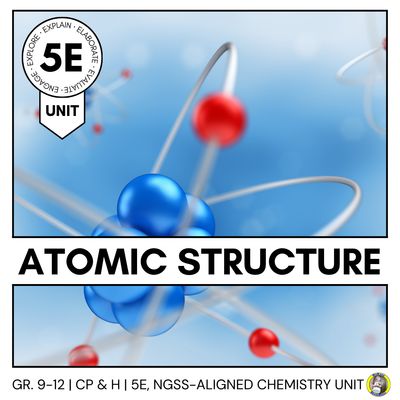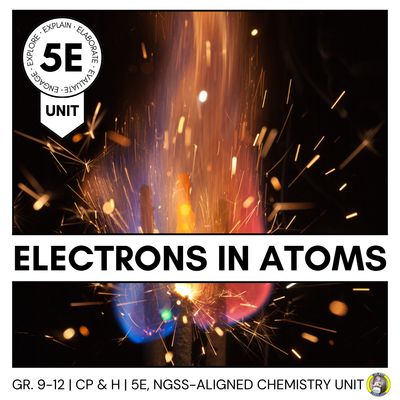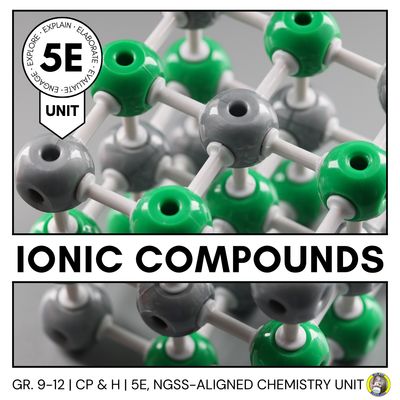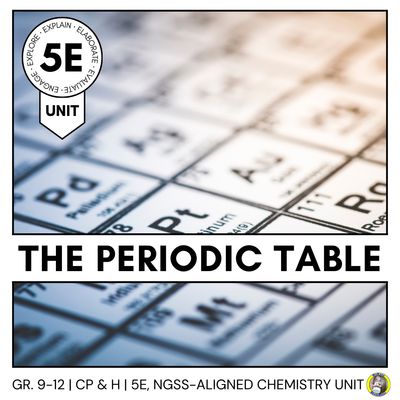TOOLS OF CHEMISTRY: 5E MODEL CHEMISTRY UNIT
Watch student engagement EXPLODE in your classroom with this new 5E-aligned unit!
What is the 5E model? The 5E model was developed by the Biological Sciences Curriculum Study (BSCS) and is an inquiry-based approach to science education designed to promote active learning through five phases: Engage, Explore, Explain, Elaborate, and Evaluate. This model helps students build a deep understanding of scientific concepts by encouraging them to connect new knowledge with prior experiences and become an active participant in the learning process. In essence, your students will learn science by doing science!
Reach all learners in your classroom using this research-supported instructional approach. This unit bundle includes everything you need to inspire, motivate, differentiate, scaffold, and assess your students in learning chemistry. This technology-infused bundle is perfect for 1:1 classrooms and flipped classrooms.
Included content:
- Scientific process
- Lab safety
- Classification of matter
- Particle diagrams
- Physical/Chemical Properties and Changes
- Scientific notation
- Measurement
- Accuracy/Precision
- Types of error (H)
- Significant figures
- Dimensional analysis
- Complex units (H)
Standards addressed:
Performance Expectations: HS-ETS1-1. Analyze a major global challenge to specify qualitative and quantitative criteria and constraints for solutions that account for societal needs and wants.
HS-ETS1-2. Design a solution to a complex real-world problem by breaking it down into smaller, more manageable problems that can be solved through engineering.
HS-ETS1-3. Evaluate a solution to a complex real-world problem based on prioritized criteria and trade-offs that account for a range of constraints, including cost, safety, reliability, and aesthetics, as well as possible social, cultural, and environmental impacts.
HS-ETS1-4. Use a computer simulation to model the impact of proposed solutions to a complex real-world problem with numerous criteria and constraints on interactions within and between systems relevant to the problem.
HS-PS1-1. Use the periodic table as a model to predict the relative properties of elements based on the patterns of electrons in the outermost energy level of atoms
HS-PS1-2. Construct and revise an explanation for the outcome of a simple chemical reaction based on the outermost electron states of atoms, trends in the periodic table, and knowledge of the patterns of chemical properties.
Disciplinary Core Ideas: PS1.A: Structure and Properties of Matter, PS1.B: Chemical Reactions, ETS1.A: Defining and Delimiting Engineering Problem, ETS1.B: Developing Possible Solutions, ETS1.C: Optimizing the Design Solution
Specific Science and Engineering Practices and Crosscutting Concepts are identified within each lesson in the teacher lesson planner.
Pre-requisite knowledge required:
This unit is designed to be the first unit in an on-level chemistry class. Ideally, your students would have working knowledge of lab safety, measurement, scientific notation, and performing simple algebraic computations.
Included learning modalities and assessments:
- (5) Guided-Inquiry Activities
- (4) Do nows
- (1) Lab Activity
- (5) Learning Station Activities
- (3) Foldables
- PowerPoint Slides {Editable}
- (3) Quizzes
- (3) Practice Worksheets
- Google™ Daily Agenda Slides for easier planning! (Just updated, September 2024)
- Formative Assessments: Google Forms™, Exit Tickets, Practice, Review Game, Video Questions {Editable}
- Answer keys and grading suggestions for all activities and assessments
- Teacher Lesson Planner: Pacing, Learning Objectives, NGSS-alignment, Teacher Tips/Prep, Assessments
- Includes differentiated lessons and assessments for both college-prep and honors level chemistry.
- Free updates forever!
Unit Duration: This unit takes approximately 2.5-3 weeks of instructional time for a traditional bell schedule. (Approximately 12-15, 50-minute periods or 7.5-8, 90-minute class periods. )
File Types: When you purchase this product, you will have access a zipped folder that contains various file types including: PDFs, Word, and PowerPoint files. External links to online resources are provided in the Teacher Lesson Planner.
Have questions? Email msrazzchemclass@gmail.com for assistance.
Enjoy!
MsRazz ChemClass
FAQs:
1. Will this resource be included as part of a larger bundle? The short answer is: Yes! Like you, I am a full-time classroom chemistry teacher, so while the process of creating and uploading resources may be slower during the school year, I have projected the following timeline (barring any emergencies) for release of each bundle:
-
Ionic Compounds, October 2024
-
Covalent Compounds, November 2024
-
Intermolecular Forces, November 2024
-
Chemical Reactions, December 2024
-
The Mole, January 2025
-
Stoichiometry, January 2025
-
Solutions, February 2024
-
Thermochemistry, March 2025
-
Reaction Rates, April 2025
- Equilibrium, May 2025
I am happy to submit a refund request for any purchases of the smaller bundles once you purchase the larger one. Just send me an email with your order number, and I will take care of the rest. msrazzchemclass@gmail.com
2. Can I use this bundle with other MsRazz resources? Absolutely! If you're not ready to completely dive into student-centered instruction, I would recommend buying the bundle and trying out a few resources from it. For example, instead of using my guided notes and PowerPoint lesson on ions, try my guided inquiry activity instead and see how it goes. Just be sure to read over the activity to ensure your students have the pre-requisite knowledge needed to be successful.
3. Is there a recommended textbook? No, not really. This bundle is designed to give your students plenty of practice with the necessary content and skills. However, I realize that some schools prefer a textbook to be available as an extra resource. Personally I use CK-12 as an extra resource for both college prep and honors-level chemistry.
4. Do I need special equipment/supplies to use this with my students? No! One of the best things about the 5E model is that students are actively engaged with outside of the classroom experiences, so many of the laboratory experiments and activities are done with household chemicals and equipment! The teacher lesson planner lays out exactly what you need and where most of these items can be purchased.
5. I am new to the 5E model, do you think I can implement this successfully? Absolutely! The teacher lesson planner walks you through each lesson and provides helpful teacher tips and suggestions for carrying out activities and assessments. If you have questions about the 5E model methodology, do not hesitate to email me. I am happy to help!
6. How is this resource different from the ones in your ENTIRE COLLEGE PREP CHEMISTRY BUNDLE? This product uses a completely different methodology for instructional delivery. If you have been a long time follower of MsRazz ChemClass, you will see some exciting new twists on similar activities, but generally, this bundle features brand new learning experiences and assessments all wrapped into one student-centered curriculum. Unlike the ENTIRE CP bundle, this resource is one stop shopping as it also includes material to teach honors-level chemistry.
Store Navigation
Each purchase is for one teacher license. If multiple teachers will be using this product, please add additional licenses to your cart.
Product Terms of Use
You may:
-
Distribute and use these resources in your classroom
-
Post this product to a password protected website
-
Distribute to all students enrolled in your class
You may not:
-
Post any part of this product on the world wide web for anyone to access
-
Copy any portion of these resources and post on the web or social media
-
Share with other teachers that your licenses have not been purchased for
Return Policy
All purchases of digital resources are non-refundable. Please be sure to verify that you have the digital applications (i.e. Microsoft, Google Apps, etc.) needed to open the documents before purchasing. Please read the description and email me with any questions.

